Archive for April, 2010
1. From a Times of India Report.
Targeting a production of about 500 tons of silk by 2020, Orissa government decided to set up a State Sericulture Research and Development Institute (SSRDI) for speedy growth of the sector.
2. From a Business Standard report:
Indo-US Collaboration for Engineering Education (IUCEE) — an initiative by the Pan IIT Alumni Association — has taken up a US co-guide PhD initiative wherein faculty members of Indian engineering institutes would be able to obtain PhDs in a four-year period, with the mentoring of distinguished US faculty.
… Under the arrangement, interested PhD candidates in India, who are currently teaching in engineering colleges, will identify and register with a PhD guide at an Indian PhD granting institution. The PhD candidate will identify his area of research interest.
If there appears to be matching of interests between an Indian PhD candidate and a US faculty, IUCEE will facilitate the process forward.
Also, the PhD candidate will make a trip to the US institution of the co-guide to ensure exposure to high quality research culture. The co-guide will also visit the Indian institution, to ensure adequate mentoring of the candidate.
… IUCEE is also exploring various avenues for requesting government of India to provide schemes for this purpose.
3. From a Times of India report:
Three of Maharashtra’s premier universities—Mumbai, Pune and Nagpur—will be split to create new universities.
…Spelling out some details, Tope said the University of Mumbai would be split into two campuses, with a pro vice-chancellor becoming the head of the new campus. The name, though, would not be altered, given Mumbai university’s iconic status, he added. He was replying to a discussion on the supplementary demands of his department.
… Maharashtra has also revived the plan to bring private universities into the state. Tope said that plans were afoot to help the corporate sector play a key role in the field of education. The Private University Act is being finalised in this connection, he pointed out.
April 16th, 2010
BIMTECH’s home page is at http://bimtech.ac.in/. In that page they have a link BIMTECH New Campus/ Bhubaneswar Orissa in the "What’s new" part. Following is the content of that document.
BIMTECH is soon going to Bhubaneshwar, the capital of Orissa, which today, is on a fast track o f development because of the proactive developmental policies of the Orissa Government under the leadership of Mr. Navin Patnaik. We have approached the state government for setting up a campus of our institute at Bhubaneshwar. Mr. B K Das, Advisor to the institute, contacted various government agencies in the months of September and October 2009. A formal proposal indicating our long term plans for setting up a state-of-the-art management institute/private university was submitted to the government. We are delighted that the Orissa Government has taken a quick decision and alloted 29.4 acres land located in a prime institutional area called Gothapatna. It is not far away from the city and the airport. The famous caves of Udaigiri and Khandgiri are in the neighbourhood of this location. Gothapatna has already been developed by the Infrastructure Development Corporation of Orissa (IDCO). Three other renowned institutions- Navratna National Aluminium Company (NALCO), India Institute of Information Technology( IIIT) and International Management Institute (IMI, Delhi) have been alloted plots in the neighbourhood. Syt. B K Birla and Dr. (Smt.) Sarala Birla, Founders and Patrons of our institute have taken keen interest in this project. Not only have they granted their permission for this project, but also wished that the campus, with all amenities and facilities, should be ready by June 2012. Dr. H Chaturvedi, Director, BIMTECH alog with Mr B.K.DAS visited Bhubaneshwar on December 5-6, 2009 and met senior officials of the Orissa Government. Dr. Chaturvedi also visited campuses of some reputed educational institutions and spoke to eminent educationists of Orissa. There has been an enthusiastic response to our plans of starting the campus from June 2012.
April 16th, 2010
Following is an excerpt from a report in Times of India.
The MSC Ed, an integrated six-year course (12 semesters), introduced in 2008 is the right way to master teaching skills. Offering quality teacher education programmes is the Regional Institute of Education that include innovative pre-service and in-service teacher training programmes and relevant research, development and extension activities.
The institute started as Regional College of Education in 1963, changed the name in 1994. It is one of the five such institutions established by the National Council of Education Research and Training (NCERT), New Delhi. The other institutes are located at Ajmer, Bhopal, Bhubaneswar and Shilong.
Prior to the six-year course, there was a two-year MSC Ed course for those who had completed BSC Ed, said Regional Institute of Education Principal GT Bhandage. "It had a good response and the students from all over the country would appear for the entrance exam. This course was conceived essentially to meet the demand of the higher secondary level in specific subjects like physics, chemistry and mathematics. Students who have passed out from this course were absorbed by Navodaya and Kendriya Vidyalaya," added Bhandage.
In 2008, MSC Ed course was introduced after completion of II PUC or equivalent. The idea was to catch them young and train them with pedagogic skills and develop adequate content competency crucial to a teacher education programme, said Bhandage.
The six years integrated course is a combination of BSc and MSC. The first four years, students study physics, chemistry and mathematics while in fifth and final year they can choose a specialization subject.
After completion of the course one can get into Higher Secondary Schools or can do research.
… The admissions are made on all India basis through an entrance exam. The selection will be based on the performance in the qualifying exam and entrance exam.
For details log on to www.riemysore.ac.in or call 514515/ 2514095.
RIE Mysore has a website at www.riemysore.ac.in. I have not been able to find a web site for RIE Bhubaneswar. I wonder if RIE Bhubaneswar offers such a course.
Considering the implementation of RTE, there is a big need for more and better trained teachers and educational administrators (headmasters, principals, vice-principals, etc.). To achieve that the government of India should upgrade the RIEs to National Institutes of Education and make them Institutions of National Importance. This will attract the attention of more good students towards a teaching and teaching administration career. The government should incraese the number of seats and number of programs in these institutes and intrdoce programs for creating top-notch Educational administrators.
April 14th, 2010
The recent news of an XIMB campus in Balangir adds a new dimension to Balangir’s knowledge infrastructure. As per the recent Business Standard report:
The XIMB campus at Bolangir will exclusively focus on the Rural Management Programme and will have an intake of 120 students.
“Our campus at Bolangir will be a fully residential facility with a built-up area of 1.55 lakh sq ft and it will only offer the Post Graduate Diploma course in Rural Management. We will phase out the Rural Management programme at our existing campus in Bhubaneswar after the establishment of the Bolangir campus”, Joseph added.
XIMB’s campus will come up about seven km from Bolangir town and the institute wants to offer a rural ambience to the students pursuing the Post Graduate Diploma in Rural Management.
XIM should aim to have this institute at the level of IRMA, Anand and put Balangir in the map with respect to rural management institutes. It should rank among the top 3-5 in the country.
Several other knowledge initiatives with respect to Balangir are also in the pipeline. This includes:
- A university and
- a WODC sponsored medical college.
There is also possibility that the state government may make some more state engineering colleges and Balangir should and would be a prime candidate for that.
Besides the above plans, some of the existing higher education institutions in Balangir are:
- Rajendra College, Balangir
- Govt. College Balangir
- Govt. Women’s College Balangir
- BB Sanskrit College, Balangir
- Food Craft Institute, Balangir (The Odisha govt. has proposed to upgrade it to an Institute of Hotel Management.)
- Government Ayurveda College, Balangir
- Sushree Institute of Technical Education, College Of Nursing, Bolangir (Offers BSc. Nursing)
- Sushree Institute of Technical Education, School Of Nursing, Bolangir (Offers Diploma Course in General Nursing and Midwifery Training)
- Four ITIs: I.T.I., Bolangir; ITI (Women), Bolangir; KBK ITC, Bolangir; Sushree ITC, Sadaipali, Bolangir
- Sushree Institute of Technical Education (SITE),Bolangir (Offering Diploma in Engineering subjects)
Balangir has good connectivity to Bhubaneswar (two daily trains: an intercity day train and Raipur-Puri Express), Sambalpur (daily trains: Koraput-Rourkela, Ispat, Balangir-BBS, Koraput-HWH, Rayagada-SBP, Raipur-Puri, Dhanbad-Allepey), Titlagarh, Jharsuguda and Rourkela in Odisha, and has two daily trains to Howrah, one daily train to Chennai and Kerala, tri-weekly trains to Bangalore, bi-weekly train to Hyderabad, a weekly train to Mumbai, and tri-weekly (to become 5 times a week) trains to Delhi from Titlagarh which is 63 kms away.
The under construction Khurda-Balangir line receiveed 120 crores in this year’s budget and hopefully it will progress at good speed and get similar and larger budgets in the coming years. If that happens then this line could get completed in another 5 years. Once this line is completed the rail connectivity of Balangir will further improve.
Politically, it has an active MP in Kalikesh Singh Deo and MLA in A. U. SinghDeo who is an important minister in Odisha. Also, its interests are being watched over by Balangir natives abroad such as Dr. Sanjiv Karmee.
So things look positive for Balangir.
The most important things to watch for and/or pursue are: Making sure that the proposed university and the medical college that are in the pipeline are indeed established; Making sure that if there are new state engineering colleges then Balangir gets one; Encouraging and enticing other private entities to establish institutes and colleges in Balangir; and Making sure the Khurda-Balangir line gets completed in 5 years.
April 14th, 2010
Update: Following are excerpts from a follow-up Telegraph report which mentions about the committee’s recommendation to have wide-spread consultations before making the changes.
But it has advised caution in implementing the reforms. The panel has suggested detailed consultations and workshops with the state governments, other top engineering institutions like the National Institutes of Technology, and private universities.
The recommendations of the panel can be fine-tuned based on the outcome of the consultations, the team led by IIT Kharagpur director Damodar Acharya has suggested. The panel is likely to meet soon and may draw up a schedule for the consultations at that meeting.
… At a meeting of the panel in Chennai on March 16 with representatives of state and central school boards, some participants suggested that rural students be given more opportunities than urban students. The participants proposed two attempts for urban students and three for rural students.
The panel and the HRD ministry will also need to convince state governments that the move to end state-specific engineering tests is not against their interests.
Following is an excerpt from a report in Telegraph.
… The panel, appointed by human resource development minister Kapil Sibal, has recommended replacing the four-decade-old IIT-Joint Entrance Examination (JEE) and myriad other engineering entrance examinations with a common test modelled on the US-based scholastic aptitude test (SAT).
The panel has suggested that the IITs accord a 70 per cent weightage to board examination scores in picking students, ..
Scores in the common aptitude test that will replace the IIT-JEE will contribute the remaining 30 per cent weightage in determining which candidates are selected, the panel has recommended.
Unlike the current engineering entrance examinations including the IIT-JEE, the common aptitude test will not have questions on physics, chemistry and math, but will test students’ powers of logical reasoning and communication skills.
If the recommendations are accepted, the IITs will for the first time admit students based more on their board examination marks than on their performance in a special entrance test.
…The minister had announced in February that he was setting up a panel under IIT Kharagpur director Damodar Acharya to study proposed reforms to the IIT-JEE. The panel was appointed in March, with the directors of the IITs in Mumbai, Roorkee and Chennai as the other members.
… The panel has recommended that the government develop a Comprehensive Weighted Performance Index (CWPI) to calculate a student’s overall score based cumulatively on his performance in the board examinations and in the common aptitude test. The report appears principally based on discussions at a meeting held with other government representatives, including Central Board of Secondary Education chairman Vineet Joshi and select state representatives in Chennai on March 16.
The HRD ministry is already working towards a plan to introduce a common high school curriculum in the sciences and math, cutting across the 35 boards — central and state — that govern Indian school education.
The common curriculum would make easier a comparison between the board examination scores of students from schools affiliated to different central and state government boards, Joshi had told the meeting.
The CWPI proposed by the panel is aimed at normalising any differences that remain between difficulty levels of school-leaving examinations under different boards.
There is a big danger that the above approach will make the XIIth exams a high stakes affair and bring it under the microscope with every aspect of it being scrutinized and judged by everyone. Most coaching classes may reinvent themselves and start coaching how to score more marks in the XIIth exam and the proposed SAT type exam. This approach may bring in bias favoring students from families with educated parents. English being a compulsory subject in XIIth, this may put students in rural areas and other areas where English is less used at a disadvantage.
So one has to wait and see how this will pan out.
My guess is if the above idea is adopted, it will go through some changes such as specific types of colleges may be allowed to give different weight to Class XII marks in different subjects. Some may introduce interviews or other tests.
One change that should be made is that when possible specialty branches should not be assigned to most students (say 70-80% in any college/institute) immediately after they join a college/institute after the XIIth. That should be determined after a year in that college/institute based on the performance in that year. This will make the class XII exam less cutthroat and ensure that students after they get into a college/institute continue to give importance to academics.
One alternative idea may to test the proposed idea (of using class XIIth marks) on 50% of the seats for a few years before deciding whether to completely abandon the current approach or not.
April 14th, 2010

April 13th, 2010
Update: For some time XIMB has been planning to expand in the Bhubaneswar area. See https://www.orissalinks.com/archives/1679. It is also interested in becoming a private university. See https://www.orissalinks.com/archives/2788. A recent Business Standard report says the following about the campus in the Bhubaneswar area:
XIMB which had kicked off its operations in the city in 1987, aimed to operationalize its second campus in the state by 2012, the year marking the silver jubilee …
… P T Joseph, director, XIMB said, “We will be coming up with two new campuses in the state- one at Bolangir and the other at Khurda. The Orissa government has already alloted us 35 acres of land at Khurda and has agreed to provide 25 acres of land on the outskirts of Bolangir town.”
The XIMB campus at Bolangir will exclusively focus on the Rural Management Programme and will have an intake of 120 students.
“Our campus at Bolangir will be a fully residential facility with a built-up area of 1.55 lakh sq ft and it will only offer the Post Graduate Diploma course in Rural Management. We will phase out the Rural Management programme at our existing campus in Bhubaneswar after the establishment of the Bolangir campus”, Joseph added.
XIMB’s campus will come up about seven km from Bolangir town and the institute wants to offer a rural ambience to the students pursuing the Post Graduate Diploma in Rural Management.
XIMB’s campus at Khurda is coming close to the campus of Orissa Engineering College.
It also seems to be making progress in the university front as tathya.in has a headline saying "XIMB University in offing".
See http://www.tathya.in/news/story.asp?sno=3962 for the news item on this in tathya.in. Following is from Samaja.
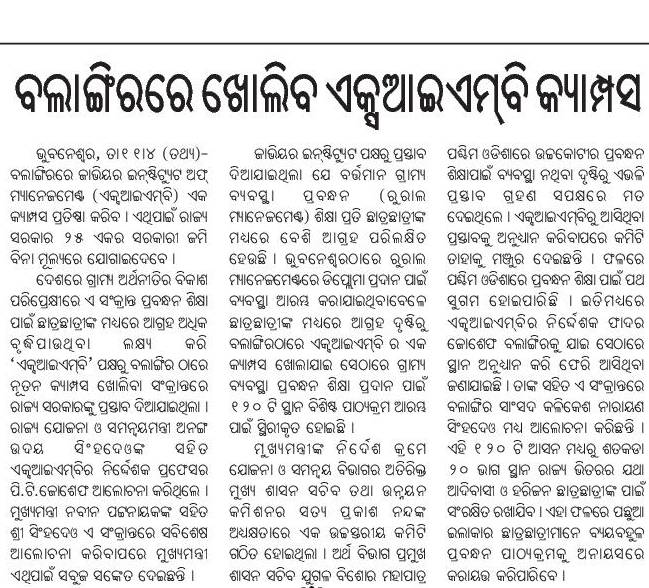
April 12th, 2010
As evident from https://www.orissalinks.com/archives/4229 Odisha needs to have more private universities, some of them in backward areas and with medical colleges, some with unique foci, and at the same time it needs to avoid having 3rd rate money spinning universities. Based on these constraints following is a first take on a guideline on how Odisha should go about allowing foundations and organizations to set up private universities in Odisha. These are preliminary thoughts, so your feedback is most welcome.
0. A foreign university that is a research 1 university in the US, or has a similar standing in the other foreign countries. (For example, they must appear in the top 300 in the Times UK ranking or the Sanghai Jiao Tong ranking.)
1. Foundations headed by people with multi-billion dollar assets and with interest in building a world-class university e.g. Anil Agarwal foundation, Azim Premji foundation, Dhirubhai Ambani Foundation, etc.
2. Foundations associated with organizations that have world-wide presence and demonstrated ability to raise sufficient money (say $100 million = 400-500 crores) to establish a top-notch university. e.g. Art of Living Foundation.
3. Foundations that have built top notch educational institutes in India (in some field). I.e., their institutes or colleges in their universities are ranked in top 20 in India in various rankings. e.g. Xaviers, Amrita University, BITS Pilani, etc.
4. A foundation that has at least one well regarded university in another state and that guarantees investment of 200 crores. e.g. ICFAI may satisfy this.
5. Existing private deemed universities in Odisha. e.g. KIIT, SOA.
6. Existing colleges or college-clusters in Odisha that have been in existence for 10+ years and are among the top 3 in Odisha in terms of student preferences that can be evaluated using the common counseling data. e.g., Silicon, NIST. [Initially 2-3 universities may be made based on this criteria and there after at most 1 university every three years can be created based solely on this criteria.]
7. Existing colleges or college-clusters in Odisha that have been existence for 10+ years, are in the top 40% in terms of student preferences that can be evaluated using the common counseling data and serve a tribal district (40% or more tribal population) without a university. E.g. Gandhi Institute in Gunupur; JITM Parlakhemundi. The head quarter of a university created this way must be in the backward district and more than 50% of its students must be enrolled in that campus. [Initially 2-3 universities may be made based on this criteria and there after at most 1 university every three years may be created based on this criteria.] (The goal here is to encourage establishment of universities in tribal districts.)
8. Existing colleges or college-clusters in Odisha that have been in existence for 5+ years, are in the top 50% in terms of student preferences that can be evaluated using the common counseling data and that have a medical college, preferably in a district without a pre-existing medical college. e.g., Hi-Tech group may satisfy this, and would be a preferable candidate when its medical college in Rourkela is up and running. [Initially 1-2 universities may be made based on this criteria and there after at most 1 university every two years may be created based on this criteria.] (The rules are relaxed here to encourage establishment of more medical colleges in districts that don’t have any.)
9. A institute that has a strong partnership with a Research 1 university in the United States or similarly recognized university in other foreign countries. By strong partnership we mean that the foreign university is willing to list this location as one of its branch campus and gives degrees that have the emblem of the foreign university. (This is to encourage collaboration with top foreign universities.)
10. A unique institute, in existence for more than 5 years, preferably promoted by a foundation with past experience in building a university, or by an internationally reputed academic. By unique, we mean something whose equivalent does not exist in the country. e.g., KISS
April 11th, 2010
SUIIT (Sambalpur University Institute of Information Technology), a constituent autonomous institute of Sambalpur University is established in the same line as IIITs to offer courses in IT related areas and to have world-class research institute in IT at Sambalpur. SUIIT will offer BTech(CSE), BTech(ECE), MSc(CS), MTech(CS) and MSc(Electronics) from this academic year (2010-11). The institute will also be taking up several research projects in the area of societal applications of IT. SUIIT is looking for faculty in area of Computer Science, Electronics, Mathematics, Physics. Persons having PhD degree from reputed institutions, good publications and interested in research career in IT are requested to apply for the position. The qualification, salary, selection process and facilities are similar to that of similar nationally reputed institutions of IT such as IIITs.
Interested persons are requested to send their cvs to SUIIT c/o VC’s Secretariat, Sambalpur University, Jyoti Vihar, Sambalpur, 768019. www.suniv.ac.in phone 0663-2430158
April 10th, 2010
(Request to readers: If you know of private state universities not listed below and not in the UGC list mentioned below, please add a link in the comment. We will update this page.)
In this page we will collect information regarding private state universities in India. By private state universities we mean privately managed universities that are establish by an act in the assembly of various states of India. These are different from the deemed universities.
The list at UGC date June 2009 is at http://www.ugc.ac.in/notices/updatedpriuniver.pdf. We also listed them at https://www.orissalinks.com/archives/2782. My guess is that these private universities which have been created by state acts have UGC approval. We have come across many other private universities which have been created by state acts which are not in this list; some of them were created by state acts after June 2009.
We start with Odisha: Odisha has passed state acts for two private universities:
- Vedanta University
- Sri Sri University
Odisha has introduced an act for ICFAI university. It has been discussed and tabled in the assembly. As of writing this, It is yet to be passed by the Odisha assembly.
Chhatisgarh: The UGC list of June 2009 lists two private universities. (i) CV Raman in Bilaspur and (ii) MATS in Raipur
Gujarat: .The UGC list of June 2009 lists five private universities. (i) DAIICT Gandhinagar (ii) Ganpat, Mehsana (iii) Kadi Sarva, Gandhinagar (iv) Nirma, Ahmedabad (v) Pandit Deendayal Petroleum U, Gandhinagar
Himachal Pradesh: It passed an umbrella private university act in 2006. The UGC list of June 2009 lists two private universities. (i) Chitkara University, Solan (ii) Jaypee, Solan. Besides them following are some new ones.
Jharkhand:
Karnataka: The UGC list of June 2009 does not have any university from Karnataka. However, since then the following has been passed.
Madhya Pradesh: It passed an umbrella private university act in 2007.
Maharashtra: From a TOI report.
Maharashtra has also revived the plan to bring private universities into the state. Tope said that plans were afoot to help the corporate sector play a key role in the field of education. The Private University Act is being finalised in this connection, he pointed out.
Meghalaya: The UGC list of June 2009 lists two private universities. (i) Martin Luther Christian (ii) Techno Global.
Mizoram: The UGC list of June 2009 lists one private university. (i) ICFAI
Nagaland: The UGC list of June 2009 lists one private university. (i) Global Open
Punjab: The UGC list of June 2009 lists one private university. (i) Lovely Professional U.
Rajasthan: It has an umbrella private university act (enacted in 2005) to facilitate creation of private universities. There are 11 private state universities in Rajasthan in the UGC list of June 2009. (i) Bhagwant University, Ajmer (ii) Jagannath University, Jaipur (iii) Jaipur National University, Jaipur. (iv) Jyoti Vidyapeeth Women’s University, Jaipur. (v) Mewar University, Chittorgarh. (vi)
NIMS University, Jaipur. (vii) Sir Padmapat Singhania University, Jhunjhunu. (viii) Singhania University, Jhunjunu. (ix) Suresh Gyan Vihar University, Jaipur. (x) Jodhpur National University, Jodhpur (xi) Amity University, Jaipur
Beyond those 11, some of the new ones not in that list are:
Sikkim: The UGC list of June 2009 lists two private universities.(i) Eastern Institute for Integrated Learning in Management University, Jorethang. (ii) Sikkim- Manipal University of Health, Medical & Technological Sciences, Gangtok.
Tripura: The UGC list of June 2009 lists one private university. (i) ICFAI
UP: The UGC list of June 2009 lists eight private universities.(i) Amity University, NOIDA (ii) Integral University, Lucknow. (iii) Jagadguru Rambhadracharya Handicapped University, Chitrakoot Dham. (iv) Mangalayatan University, Aligarh (v) Mohammad Ali Jauhar University, Rampur. (vi) Sharda University, Gautam Budh Nagar. (vii) Swami Vivekanand Subharti University, Meerut. (viii)
Teerthanker Mahaveer Univesity, Moradabad.
Uttarakhand: The UGC list of June 2009 lists six private universities.(i) Dev Sanskrit Vishwavidyalaya, Haridwar. (ii) Doon University, Dehradoon. (iii) Himgiri Nabh Vishwavidyalaya, Dehradun. (iv) ICFAI Dehradun (v) University of Petroleum and Energy Studies, Dehradun. (vi) University of Patanjali, Haridwar.
West Bengal: The UGC list of June 2009does not have any from West Bengal. However, the following has been passed by West Bengal assembly since then.
- Dhirubhai Ambani Institute of Information and Communication Technology, Kalyani
In regards to umbrella private university bills, as per http://www.academics-india.com/SC%20judgement.htm the Supreme court in
Prof. Yashpal & Anr. Vs. State of Chhattisgarh & Ors.
Coram: CJI ,G. P. Mathur , P.K. Balasubramanyan 11/ 02/ 2005
CASE NO.: Writ Petition (civil) 19 of 2004
PETITIONER: Prof. Yashpal & Anr.
RESPONDENT:State of Chhattisgarh & Ors.
DATE OF JUDGMENT: 11/02/2005
BENCH:CJI,G. P. Mathur & P.K. Balasubramanyan
has reiterated (see point 36) UGC rules that say:
3.1 Each private University shall be established by a separate State Act and shall conform to the relevant provisions of the UGC Act, 1956, as amended from time to time.
3.2 A private university shall be a unitary university having adequate facilities for teaching, research, examination and extension services.
The following table summarizes the private and deemed universities in various states of India. The data regarding deemed universities is from http://pib.nic.in/release/release.asp?relid=50713. Since the HRD minister Mr. Sibal has said that the deemed university system will vanish, most of the private deemed universities will become private state universities.
| State |
# private universities in June 2009 |
# deemed universities |
# private universities in pipeline that we know of (work in progress) |
Total |
| Andhra Pradesh |
0 |
7 |
|
7 |
| Arunachal Pradesh |
0 |
1 |
|
1 |
| Bihar |
0 |
2 |
|
2 |
| Chhatisgarh |
2 |
0 |
|
2 |
| Gujarat |
2 |
5 |
|
7 |
| Haryana |
0 |
5 |
|
5 |
| Himachal Pradesh |
2 |
0 |
5 |
7 |
| Jharkhand |
|
2 |
1 |
3 |
| Karnataka |
|
15 |
1 |
16 |
| Kerala |
|
2 |
|
2 |
| Madhya Pradesh |
1 |
3 |
|
4 |
| Maharashtra |
|
21 |
|
21 |
| Meghalaya |
2 |
|
|
2 |
| Mizoram |
1 |
|
|
1 |
| Nagaland |
1 |
|
|
1 |
| Orissa |
|
2 |
3 |
5 |
| Pondicherry |
|
2 |
|
2 |
| Punjab |
1 |
3 |
|
4 |
| Rajasthan |
11 |
8 |
4 |
23 |
| Sikkim |
2 |
|
|
2 |
| Tamil Nadu |
|
29 |
|
29 |
| Tripura |
2 |
|
|
2 |
| Uttarkhand |
6 |
4 |
|
10 |
| Uttar Pradesh |
8 |
10 |
|
18 |
| West Bengal |
|
1 |
1 |
2 |
| Delhi |
|
11 |
|
11 |
April 10th, 2010
Following is an excerpt from a report in ibnlive.com.
There is a story about how Cassius Clay changed his name to Mohammed Ali. There is an equally interesting anecdote about how Jagran Integrated Business School changed its name to Leeds Metropolitan University. Abhishek Mohan Gupta, director (marketing and strategic development) of Jagran Social Welfare Society, which runs Jagran Integrated, wanted to get his alma mater Leeds Met into the country. For five years, he waded through the maze of government approvals. No luck. Leeds remained out. And Gupta remained stuck.
He then used his last trick. He told the government that he wanted to change Jagran Integrated’s affiliation from Barkatullah University to Leeds Met. Nobody had made a request like that before. The absence of precedent befuddled the mandarins who govern higher education and they ended up giving it a go ahead. Overnight, the soul of Leeds Met entered the body of Jagran Integrated. Last year, 70 students were studying there in four programmes. This year, Gupta is ramping this up to 13 programmes. In a few years, Gupta wants to enroll 1,000 students.
That’s not all; Gupta thinks he can use the 36-acre campus even more efficiently. He plans to add two more universities, make student accommodation and food court common to all three and dub the whole thing an "education city”. He has been talking to Nanyang University, Singapore, and New York University for different programmes. He plans to use the same change-of-affiliation route, though things have now gotten easier.
The partnership with Leeds Metropolitan University is also mentioned in this PR piece.
The JSWS (Jagran Social Welfare Society) has also plans for a 200 acre 509 crore university in Bhopal.
April 10th, 2010
Following is an excerpt from a report in Telegraph:
The association’s board of governors has recommended the feasibility of 78 more Kendriya Vidyalayas (KV) as part of the process initiated by the HRD ministry for expanding the network of such central schools during the 11th plan period. The feasibility report included two KVs in Cuttack along with nine others across Orissa to address the educational needs of children of central government employees who are frequently transferred.
At present, there are 36 KVs in Orissa. While nine schools are in the project and defence sectors, the rest are in the civil sector.
The existing 36 Kendriya Vidyalayas are listed in http://kvsrobbs.org/DirectorKVs.html. As per that list the latest ones established in 2007 are in Rayagada, Parlakhemundi, Boudh, Malkangiri, Nawrangpur, Kandhamal, and Bhadrak. So the districts in Odisha that do not yet have Central Schools are:
- Deogarh
- Jajpur
- Kendrapada
- Nayagarh
- Nuapada
- Sonepur
I hope the new ones will cover these districts.
See our earlier articles on this topic at https://www.orissalinks.com/archives/556, https://www.orissalinks.com/archives/550 and https://www.orissalinks.com/archives/227.
April 9th, 2010
Following is from http://www.dst.gov.in/whats_new/whats_new10/fellowship10.pdf.Thanks to a reader for the pointer.
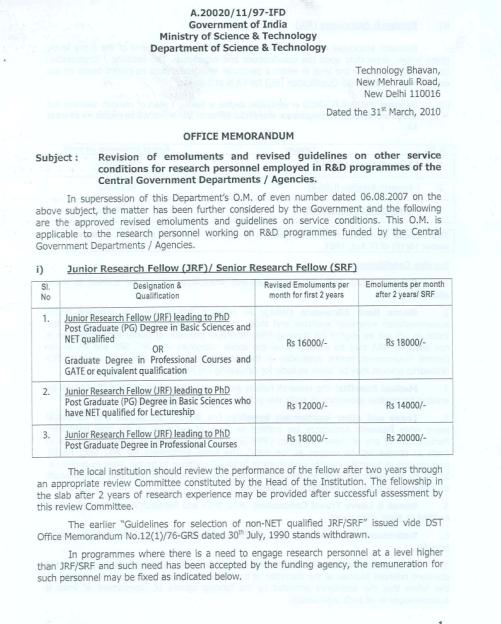
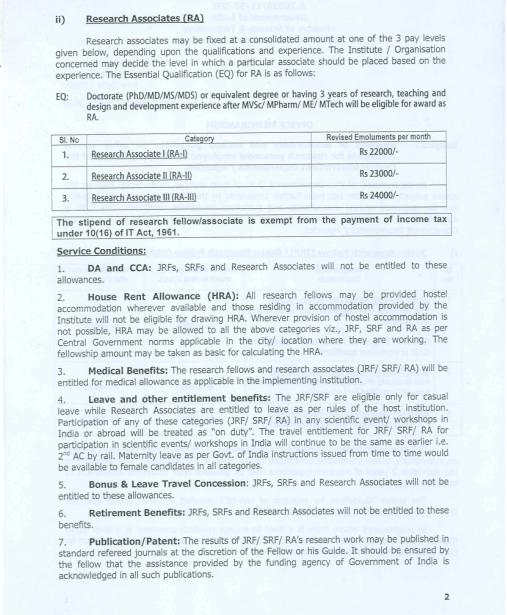
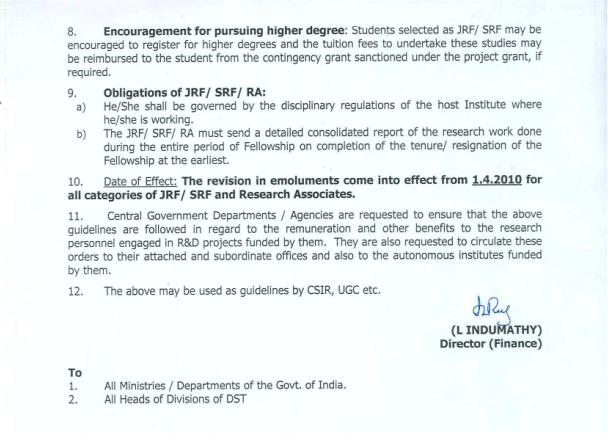
April 8th, 2010
Following is an excerpt from a report in Business Standard.
… The HRD Ministry is set to revise its vocational education scheme under which the students will have the option to pursue vocational studies as an exclusive stream on par with arts, science and commerce.
The revised scheme, modelled on the pattern of vocational education in Australia and Germany, is expected to be announced next month.
"Students can study exclusively vocational education at Class-XI and XII. This will be an additional stream to the existing streams of science, arts and commerce," a senior Ministry official told PTI.
The focus of the revised vocational education stream will be industry collaboration at all stages, starting with designing of the courses, teaching and work experience in industry.
It will ensure employability of the students. Students can join any job or pursue further studies in professional courses like B.Tech after completing vocational courses.
… The vocational stream will offer a number of courses in areas like hospitality, automobile sector, paramedics, cooking, truck driving, manufacturing, graphics designing and animation, the official said.
Under vocational stream, the programmes will comprise 70 per cent of subject specific studies and 30 per cent general studies like English and communicative skills.
The revised scheme will be implemented across the country with 100 per cent Central assistance. The government has earmarked Rs 2,000 crore in the 11th Plan for this scheme. The Ministry is preparing a note for approval of Expenditure Finance Committee. Then it will go for Cabinet’s approval.
This is a great direction. When mainstream colleges start offering vocational courses and these programs have tie-up with industries that hire the graduates in apprentice positions with good prospects, the stigma associated with vocational programs in the mind of a typical middle class family in India would significantly reduce.
April 6th, 2010
Update on April 6 2010: Reader and commentator Debi Prasanna Sarangi sent us the following screen capture that shows Anil Agarwal Foundation (the promoters of Vedanta University) to be a public company. But it does not show when exactly it became a public company. Regardless, an important part of the Honorable Lokpal’s conditions (see the sentence in bold red in the first paragraph below the image) seems to be satisfied now.

Following is an excerpt from an article in Economic Times.
… Acting on a petition filed by Dwaraka Mohan Mishra, a trade union leader, the Lok Pal last week had asked the state government to submit a report within three months after complying with the recommendations given by him in this case. The Lok Pal has also recommended a moratorium on the project till the Anil Agarwal Foundation complies with the legal provisions pointed out by the Ministry of Company Affairs for conversion of its status from private to public company.
Legally the state government could acquire land for the Anil Agarwal Foundation if the Foundation was a public company. This has been the consistent view of the Law Department of Government of Orissa. The then Orissa chief secretary approved the proposal for land acquisition in the instant case on the 12th December 2006. Accordingly lands belonging to private persons as well as to Shri Jagannath Temple were gradually acquired. But no previous sanction of the state government was taken before acquiring the land belonging to Shri Jagannath Temple though previous sanction was mandatory as per Section 16 of Shri Jagannath Temple Act, 1954, which has embroiled Anil Agarwal Foundation into fresh trouble, officials said here.
Justice Patra has made it clear that if the Jagannath Temple Act and the Land Acquisition Act have not been complied with, no temple land could be handed over to the Foundation for the proposed University. Besides, he has recommended that the state government should work out a scheme for phase-wise delivery of land required for the university project. He also suggested that the vigilance cell should monitor the progress of the project and see that land is acquired and delivered in a phase-wise manner to the foundation so that it is not misused.
Justice Patra has asked the state government to ensure payment of adequate compensation by the Foundation to those affected by the project.
No matter how important Vedanta University could be or is for Odisha, all applicable laws need to be followed. Thus I agree with the Honorable Lokpal Justice Patra’s recommendations. I also like his constructive approach underlined above.
Following is a report from Sambada that includes a response from the Vedanta University officials on this controversy.
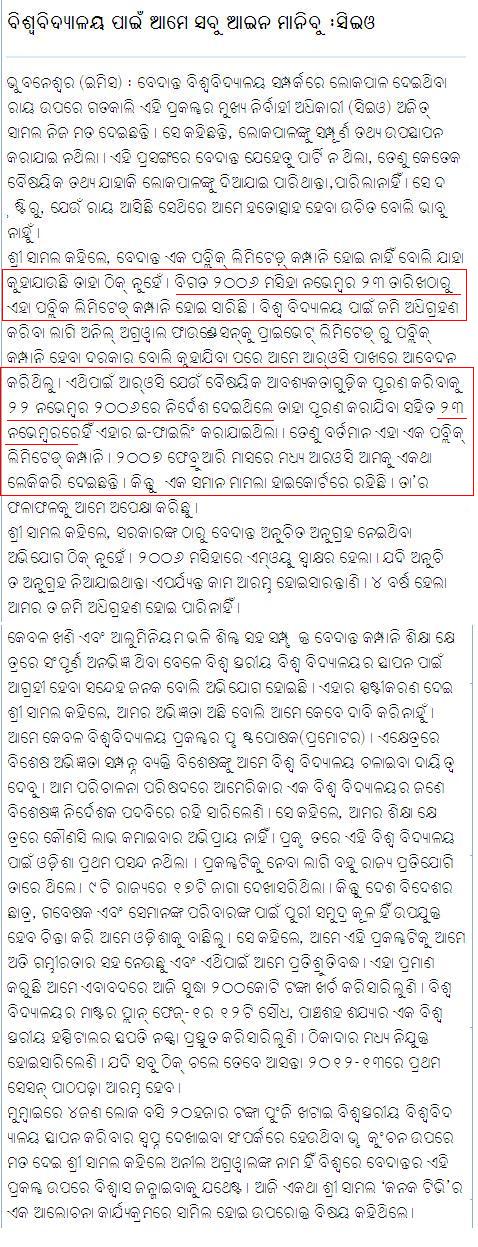
There are various other reports, including by Mr. Prasanna Mishra (whom I respect a lot) and in tathya.in. Mr. Mishra’s report gives a time line and the tathya.in report includes Vedanta University’s clarification. Having gone through all that at this point my thoughts are:
- The Honorable Lokpal probably had the most information; he heard the government officials’ take on the issue and as a retired justice he knows what is legal and what is not and what is important and what is not. So I am supportive of his recommendations.
- However, it seems like (based on the tathya article and the Sambada report) the Honorable Lokpal did not ask Vedanta University for their side of the issue. (I assume that was not a legal requirement.) But it is possible that some of the issues that are raised (such as the status of the Anil Agarwal foundation) are already resolved. (The Sambada and tathya articles suggest that.)
- I am especially thankful to the Honorable Lokpal for his constructive recommendations. Vedanta University is important for Odisha, but so are the people and their sacrifices. So it is important to have Vedanta University in Odisha so as to raise Odisha from the bottom of every parameter and instead make it a knowledge hub of the world and also address the higher education concerns of India; but at the same time it is equally important that the people and their sacrifices do not go to waste and their interests and rights are adequately protected. The Honorable Lokpal’s recommendation, as reported by the Economic Times article, seems to take care of both of the above aspects.
April 5th, 2010
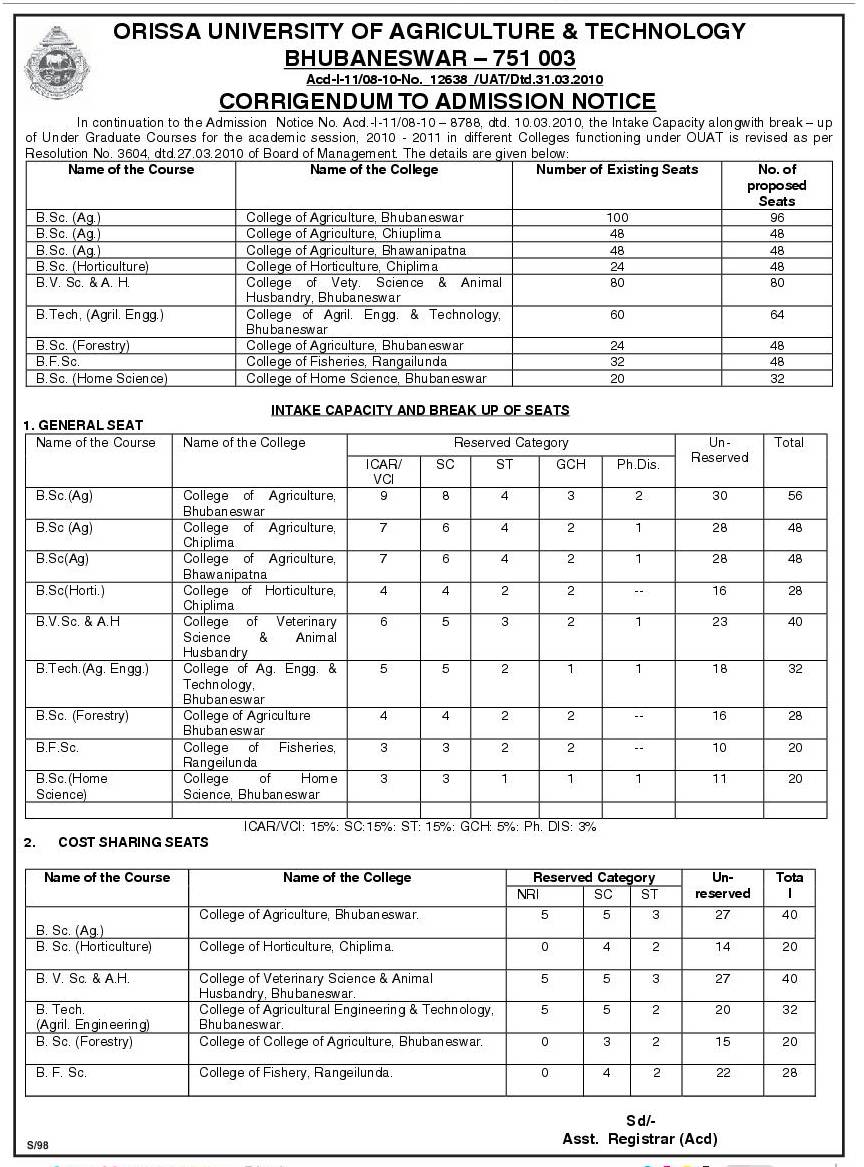
April 4th, 2010
Next Posts
Previous Posts








